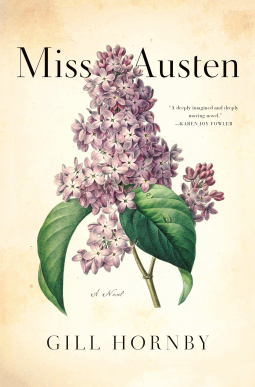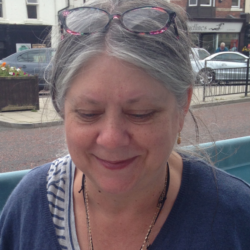Thank you Gill Hornby, Flatiron Books and NetGalley for gifting me this digital ARC in exchange for an honest review. The book will be published in the US on April 7, 2020.
Gill Hornby treats her readers to a thoughtful reimagining of Jane Austen’s adult life and early demise utilizing the point of view of her older sister, Cassandra—the story also moves back and forth in time, a favorite plotting device for me.
Using brilliantly reimagined correspondence and conversations the story dips into the shared life of Jane and Cassandra and in doing so pays a lovely tribute to sisterhood, friendship and the various choices the women characters in this novel make out of a sense of duty. Duty not only to family but to creative genius as well.
Two decades after Jane’s death this novel finds Cassandra- now in her 60’s— working to preserve her sister’s reputation. Cassandra wants to shape the narrative so that her sister’s life is perceived as forever calm—unruffled by drama and scandal. She feels it is her duty to curate Jane’s good reputation—she seeks to portray Jane’s life as one of quiet creativity, spent in the sheltering bosom of her happy family.
In 1840, upon learning of the passing of a family friend’s husband, the Reverend Fowle, Cassandra journeys uninvited to the vicarage under pretense of offering her “unasked for” assistance to the Reverend’s youngest daughter—Isabella— as she must now vacate the rectory to make way for the incoming Reverend and his family.
The late wife and mother, Eliza Lloyd Fowle— is portrayed here as having been an intimate confidante of both sisters, particularly Jane. The true purpose of Cassandra’s visit is to gather and collect a cache of correspondence before her sister-in-law Mary can lay claim to these letters and potentially exploit them to the detriment of Jane’s reputation.
This particular rectory also served as family home to her long dead fiancé Tom Fowle and as Cassandra begins to sift through the letters she becomes swamped by memories and overwhelmed by the emotions stirred up by this unexpectedly personal revisiting of the past.
Cassandra’s determination to find Isabella settled before she leaves for home fuels the real-time scenes as she attempts to project the solution that worked best for the Austen sisters on to the Fowle’s—looking to her own past to shape the future for these three unmarried sisters.
Two are spinsters and one a widow and Cassandra instead of seeing the realities in front of her nose—the actual circumstances and genuine wishes of these three sisters—deems it best to impose her own vision for a seemly satisfactory resolution.
Ms. Hornby’s novel is in part a gentle examination of 19th century spinsters amidst various layers of society and how they individually handle this reality. As a woman of a certain age, living on her own but dependent on various means of support and income, I love reading about how other women through time handle this circumstance for themselves.
I feel that sharing how things further develop both in the past and at the rectory will come at the expense of supplying spoilers and this is not fair to other readers or to the author. But I cannot resist a little more commentary on the 19th century life of the Austen sisters as I always enjoy learning something new when I am reading.
I had been saving this semi-epistolary NetGalley ARC in my queue for awhile as I was planning a reading “arc” of epistolary novels to ring out 2019. Lady Susan, Jane Austen’s only foray into this literary plotting style and already on my proposed reading stack is a novella which is widely considered one of her most ambitious and sophisticated early works. A true moment of #TBR serendipity!
I have not read a lot of Jane Austen—I am not a Janeite by any means—I have read Pride & Prejudice which I greatly enjoyed. I have also read a few books that reference Jane Austen and her writings such as “The Jane Austen Book Club”. I know little about her personal life and absolutely nothing about Cassandra Austen.
Therefore I decided to just read “Miss Austen” first and then take a deeper look after I finished so I could suss out the history from the fiction. I took the same approach with existing reviews as I didn’t want those to color my own assessments either.
While most people loved it— others had divergent reasons to take fault— some reviewers took umbrage against Ms. Hornby for taking “too many” fictional liberties and chastised her fiction for not being 100% historically accurate— to the polar opposite with other reviewers who opined that Ms. Hornby took “too few” fictional liberties and wished that she had padded the historical scarcity of information regarding Jane’s life with fictional additions of drama, adventure and spice. Go figure.
I read the book at face value as it is billed— historical fiction— a fictionalized account of Jane Austen’s life, one the most famous female authors at the turn of the 19th century, as told by her older sister, Cassandra Austen. I had no preconceived notions about what I would find—my hope is this lack of partiality allows for a review of this novel on its own merit.
I loved the slow pace of “Miss Austen”. I felt that Gill Hornby employed a writing style that allowed for rich detail and enjoyed the slow unveiling of a character’s depth—a reward for patient readers of such period dramas.
Quintessentially and in my own opinion, “Miss Austen” reads as if penned by Jane, herself, in that there is no edge of the seat action, no deep mysteries, or high flying adventures just the deep study of her characters and their personalities. Particularly— this novel takes a deeper look into how 19th century women made their way through life, especially those driven to the fringe of society, such as spinsters and widows.
Jane Austen is famous for writing books and short stories that often centered on the dependence of women on marriage to provide both favorable social standing and economic security and were written with a biting sense of irony, realism, humor and social commentary.
Ms. Hornby stays true to this course and her writing utilizes all of these elements as she weaves in imagined letters and conversations with what little facts are known about the lives of these two sisters. In reality there are few autobiographies written about Jane Austen excepting those by family members and indeed there is a paucity of information regarding a record of Jane’s life, much less Cassandra’s— but isn’t that true for most all women?
According to Austen scholars Jane may have written as many as 3,000 letters during her life time but only 161 survive. Many of these letters were written to her sister Cassandra who in 1843 burned the greater part of them and cut pieces out of those she kept.
Much of this particular book involves the period of time in which Cassandra destroyed all of Jane’s letters. Ms. Hornby’s richly imagined letters and remembered conversations begin with Cassandra’s engagement to Tom Fowle, his tragic death, and continue on up and through Mr. Austen’s sudden retirement and the family’s move to Bath, his subsequent death, the unsettled times that followed, life at Chawton, and Jane’s early death.
This much we know is true:
The Austen’s were always a family of modest means but the situation became more tenuous for Cassandra, Jane and their mother after the death of Mr. Austen, with no steady income of their own they became beholden upon the generosity of their brothers(sons) for economic support.
Cassandra supposedly destroyed the letters to protect family members and others from reading Jane’s often acid commentary and forthright speaking. She is presumed to have destroyed all correspondence that she deemed tactless, unbecoming, or unseemly.
Cassandra is not the only guilty party as going forward successions of Austen generations expunged and sanitized Jane’s life history and the vast majority is biased in the favor of “good quiet Jane” who lived in a happy domestic situation with family as her mainstay.
It is true that Cassandra destroyed all of Jane’s correspondence between the years of 1801- 1804 which also parallels a time when Jane did very little if any writing. Ms. Hornby mines these hidden truths and imagines a story that points to something different: deep periods of unhappiness, bitterness and disappointments.
In real life Cassandra and Jane were quite inseparable and shared a special bond as sisters and friends. Cassandra spent the majority of her long life both caring for Jane and others as well as preserving the memory of her sister. Cassandra is often viewed as Jane’s prudish stiff older sister but the fact remains that what little we know of Jane comes from Cassandra and those 161 remaining letters.
On a personal note, I am childbirth educator, prenatal yoga instructor and birth doula, so I wanted to take a moment to commend Ms. Hornby for her representations of childbirth during the late 18th and early 19th century England. She wrote them as common matter fact occurrences in a woman’s life, without fuss or drama, Cassandra was at hand so she assisted the depicted births by expediently doing what needed done. Women helping women—a time honored tradition.
How Ms. Hornby masterfully weaves together the known facts regarding Jane and Cassandra Austen with the thoughtful fabrication of quite plausible fictions makes for reading time well spent. I look forward to more of her books.
About the Author:
Gill Hornby is the author of the novels The Hive and All Together Now, as well as The Story of Jane Austen, a biography of Austen for young readers. She lives in Kintbury, England, with her husband and their four children.



Comments powered by CComment